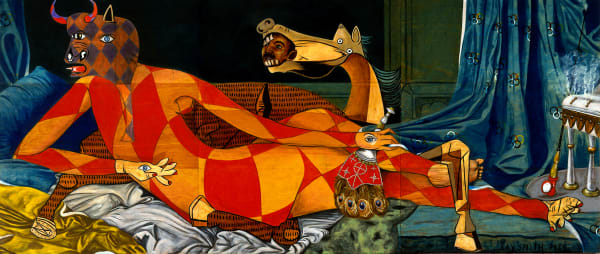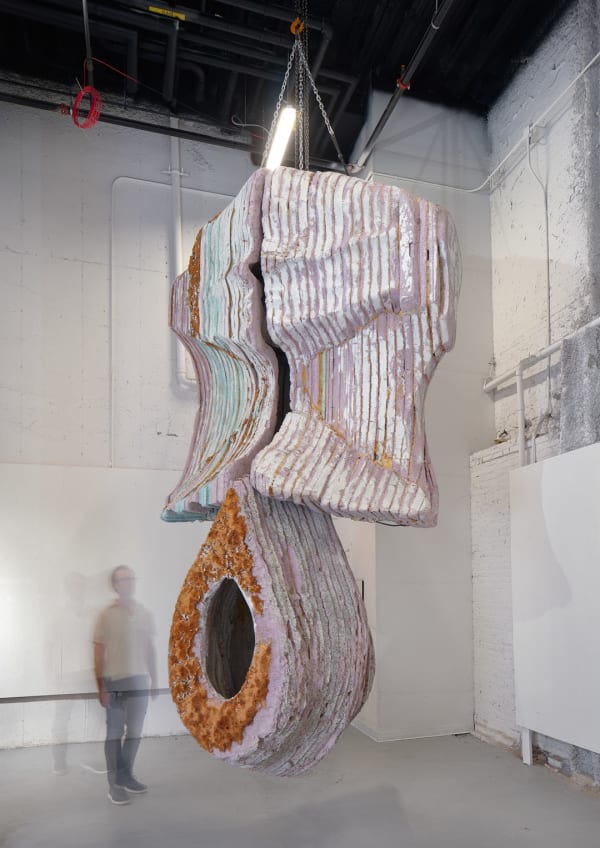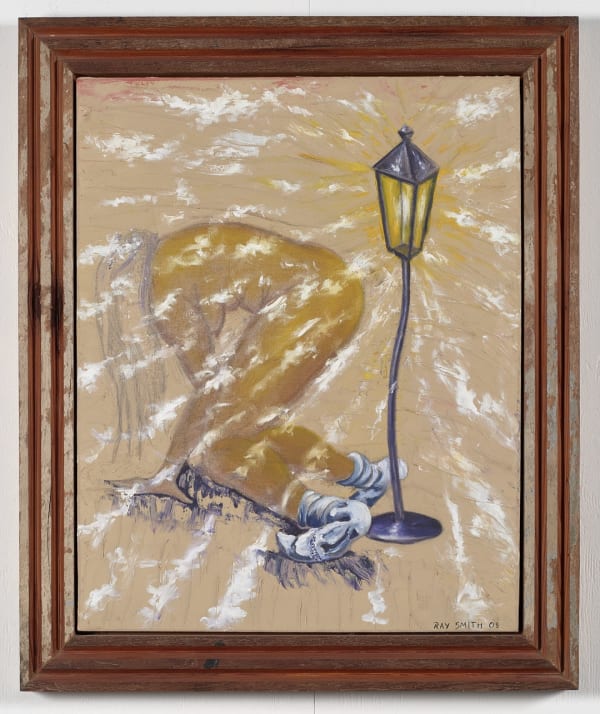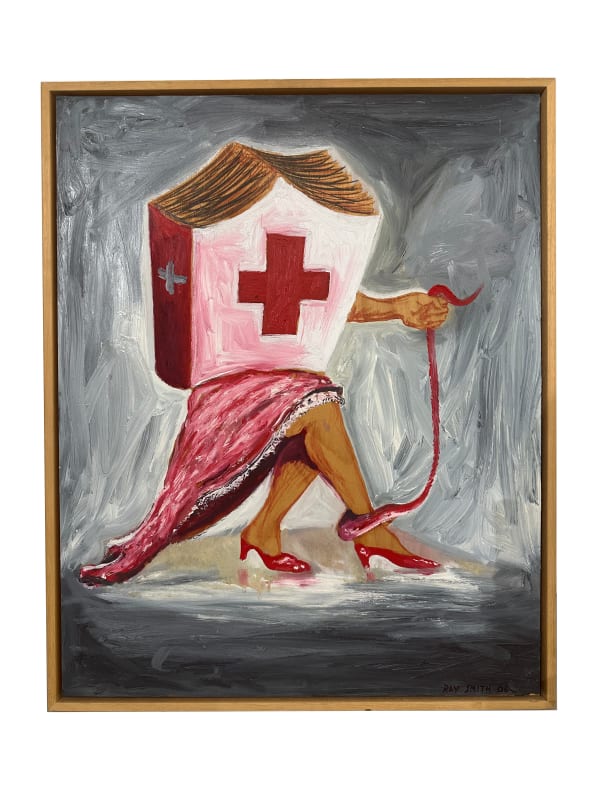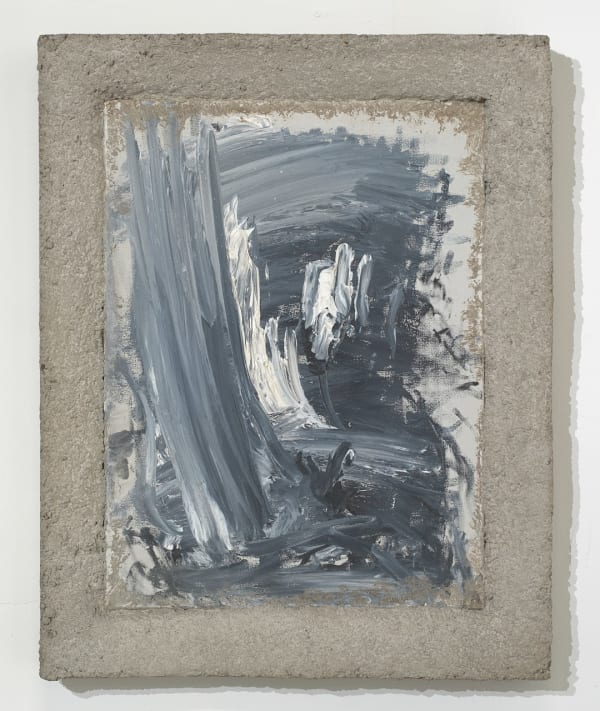It is with privilege and great honor which Ethan Cohen Gallery announces Ray Smith: Nepantla, the artist’s first solo exhibition with the gallery. At a juncture of polarizing identity politics, Smith’s exhibition is particularly poignant not only in its monumentality and virtuosity but also in the sensitivity he brings to each subject. Smith’s works are timely and highly personal yet, Smith’s paintings address concepts that transcend identity and resonate to the very core of the human condition. Simultaneously Smith’s approach to painting subverts the norms of American art history.
Organized less as a conventional gallery presentation and more in line with an institutional approach, the exhibition’s unique tenor is further compounded by the raw quality of Ethan Cohen’s cavernous new Chelsea gallery. The works on view are not limited to a current body of work, rather the exhibition was conceived around one of Smith’s most seminal paintings Guernimex III (La Olympiada, 1989-1990), which is set in dialog with Smith’s most recent monumental sculptures Lagrimas de Espuma/Foam Tears, 2014 - 2024 and Cocoon 2014 - 2024. The extent of the works included encompass five decades of paintings and sculptures and draw on loans from private collections with the aim of highlighting the breadth of Smith’s oeuvre while focusing on the specific concept of Nepantla.
The term was first used by the indigenous people of central Mexico, the Nahaus, in the Florentine Codex, which preserves the knowledge of the ilamatlācah or "wise old women”–
“Tlachichiquilco in tihuih in tinemih tlālticpac: nipa centlami, nipa centlami. In tlā nipa xiyāuh in tlā noceh nipa xiyāuh ōmpa tonhuetziz: zan tlanepantlah in huīlōhua in nemōhua.”
“We travel along a mountain ridge while we live on earth, an abyss yawning on either side. If you stray too far one way or the other, you will fall away. Only by keeping to the middle way does one walk on and live."[i]
Some five hundred years later the wise women’s words are a timely statement given the current political climate. Nepantla has been assimilated into the post-colonial discourse to describe a state of in-betweenness, specifically the state that exists when one simultaneously straddles two cultures. It also may refer to a literal space of the borderlands between the United States and Mexico. Having been born (on the aforementioned border) in Brownsville, Texas, Smith holds both American and Mexican citizenship. The meaning and use of the term has shifted over time, “According to Gloria Anzaldúa, Nepantla is also conceptually infinite; it is a ‘space where you are not this or that but where you are changing.’ A physically confining yet theoretically expansive space.”
[ii] This is the liminal space which Smith’s work occupies. Moreover, Anzaldúa has suggested there is “no fixed identity” opening the interpretation to many different contemporary lenses.
This liminal state of in-betweenness may be considered from the vantage point of Smith’s divergent and thought-provoking relationship to Art History. Conventional art history dictates American Art is indebted to European traditions but breaks from it in the post war era. However, as can be seen from Smith’s personal artistic geology, there exists another course to be examined. Currently, we may be able to better reconsider the tract of American Art by tracing it not merely from Paris to New York, but from Paris, to Mexico, to New York. The influence of expressionistic qualities and the monumental ambition of José Clemente Orozco, David Alfaro Siqueiros, and Diego Rivera can be seen directly in the Abstract Expressionists. As can be inferred from Jackson Pollock’s claim that Orozco
’s Prometheus was “the greatest painting in North America”
[iii] The significance of this is, within this context evidence of the indigenous remains, a tendency towards the figurative traditions of Catholicism can be felt, the underlying conditions of postcolonialism make themselves heard, and perhaps a whole plethora of interpretations which give not only meaning but a historic sense of cultural identification to a broader spectrum of the American peoples.
Fundamentally, Smith’s paintings and sculptures contend with concepts that transcend identity and resonate at the very core of human nature. One of the ongoing themes present in Smith’s work, which is specifically highlighted in the exhibition, is that of birth. Birth relates to the concept of Nepantla, in that pregnancy is a liminal space between two identities. This discourse is evident in Smith’s Origin, which alludes to Gustave Courbet’s L’Origine du monde, citing the feminine as the originator of life. Similarly, in Smith’s La Dona de Pato, 1988, we see Nepantla (or a liminal state of being and not being) presented as a representation of literal pregnancy. At the time, it was painted when Smith’s wife was pregnant for the first time. Likewise in Smith’s Cocoon, we see a woman’s head emerging from the negative space of the sculpture. In practice, many of Smith’s sculptures are produced in a manner in which the negative space of one sculpture begets the positive of another. In a similar relationship as that between molds and casts.
Smith’s monumental sculptures are brutalist yet embrace the primordial tradition of depicting the female form, as a center of origin and birth. The seductive surfaces of the sculptures retain Smith’s propensity for his painterly penchant. The surfaces have been painted and weathered by entropic means and further worked through an extensive and unique process of caressing and attending to every inch of the piece by hand in a reductive process which propels the painterly aspect of the work. As such these works further reiterate the theme of Nepantla (or a liminal state of in-betweenness) as they are clearly conventional sculptures, yet they resonate through their approach to painting.
The concurrent inclusion of contradictory aesthetic styles or norms prevails throughout Smith’s work. His style may be recognized at first as quintessentially postmodern, this observation might be apt, due in part to the fact that Smith’s mature style emerged in the early eighties. This is evident in his seminal work Guernimex III (La Olympiada), 1989-1990. The monumental painting measures 9 x 20 ft and is a cacophony of aesthetic approaches and simultaneously alludes to Picasso’s Guernica, Jean-Auguste Ingres’ Odalisque, and includes a nod to the Olympic games.
Throughout Smith’s oeuvre it can be seen he is clearly looking to Spain and her avant-garde. Smith regards Picasso for his cubist and collage contributions, as can be seen in both his Unguernica series and his Exquisite Corpses. Dali’s surrealist subversion of naturalism can also be seen in both early and late examples of Smith’s work; however, the true complexity of his artistic contribution follows the same path as his own personal journey. Smith presents the viewer with this subversive approach to considering the arc of American Art history all the while contributing his own personal voice and context to the discourse of Contemporary Art. One in which the influences of indigenous American culture and the painterly legacies of the Mexican muralists supplant the predilection of the continental protestants towards minimalism. By contrast, the predisposition to proliferate images (such as that of saints, icons, and so forth) common to Catholic cultures engendered its population towards a natural inclination to include figuration in art. This may stand to reason why it seems so natural for Smith to engage in multiple simultaneous aesthetic approaches to the figure. Furthermore, it is ironic that at this exact moment when so many were decrying painting’s death, Smith would paint many of the works in this exhibition, addressing the subject of birth.
About Ray Smith:
Ray Smith (American, b.1959)
Born in Brownsville, TX, and raised in Central Mexico.
Ray Smith emerged in the 1980s, and continues to produce exuberant paintings and sculptures characterized by an inimitable style and subject matter that reflect his bi-cultural American and Mexican heritage. Contorted and morphed figures recur throughout his work, in a hybrid that draws from his early studies of fresco painting with traditional practitioners in Mexico, and an indebtedness to Picasso, the Surrealists, and the politically daring Mexican muralists. Through these varied beings, Smith reflects upon the complexities and absurdities of society, family, politics, culture, war, and the human condition itself, framed by birth and death.
The artist has exhibited extensively around the world. He participated in the Whitney Biennial in New York City. He has been represented by Gagosian and Sperone Westwater, and exhibited with visionary gallerists such as Bruno Bischofberger, Thaddaeus Ropac, Daniel Templon, and Annina Nosei, amongst others.Smith’s work has since been exhibited at The Museum of Modern Art, Musée National dʼArt Moderne at the Pompidou Center, The Whitney Museum of American Art, The Metropolitan Museum of Art, The Museo Nacional Centro de Arte Reina Sofia, The Brooklyn Museum, National Museum of China, Beijing, Kunsthalle Cologne, Perez Art Museum, San Antonio Museum of Art, San Jose Museum of Art, Museo de Aguascalientes Museo del Palacio de Bellas Artes, Mexico DF, The High Museum of Art, Museum of Fine Arts in Houston, The Centro Cultural de Arte Contemporaneo in Mexico City, Neuberger Museum, The Tacoma Art Museum, Museo Alejandro Otero, The Art Museum of South Texas, Centro Cultural de la Raza and Museum of Contemporary Art, Katonah Museum, Huntsville Museum of Art, Museo de Arte Contemporáneo de Monterrey, Fundación Joan Miro, Museo Casa Natal, The Drawing Center, The Broad, and the Menil Collection.
About Ethan Cohen Gallery:
Ethan Cohen Gallery has represented both emerging and internationally renowned artists for over thirty years. Many of the emerging artists have now become household names. The gallery occupies a distinct place in contemporary art as a center of innovation across disciplines and countries. It serves artists and clientele through global art fairs, curatorial projects with top institutions, and as a center for seminal cultural events. Today Ethan Cohen Gallery has three gallery locations, two in Chelsea in the heart of New York City and the other in The KuBe Art Center in Beacon, New York.
The Ethan Cohen Gallery was first founded in 1987 as Art Waves/Ethan Cohen in SoHo, New York City. A groundbreaker in the field of contemporary Chinese art, Ethan Cohen was the first gallerist to present the Chinese Avant-Garde of the 1980s to the United States.
Press Contacts:
Dan Schwartz:
Lara Kamhi:
lara@ecfa.com
[ii] Torres, Gerald, Nepantla/Coatlicue/Conocimiento, The Michigan Law Review, April 2023
 Ray Smith, Guernimex III (La Olympiada), 1989-90
Ray Smith, Guernimex III (La Olympiada), 1989-90 Ray Smith, La Dona de Pato, 1988
Ray Smith, La Dona de Pato, 1988 Ray Smith, Foam Tears, 2024
Ray Smith, Foam Tears, 2024 Ray Smith, Cocoon, 2024
Ray Smith, Cocoon, 2024 Ray Smith, Origin, 2005
Ray Smith, Origin, 2005 Ray Smith, Dona de Ganso, 2008
Ray Smith, Dona de Ganso, 2008 Ray Smith, Umo, 2006
Ray Smith, Umo, 2006 Ray Smith, Enfermera II, 2006
Ray Smith, Enfermera II, 2006 Ray Smith, Martin's Drunk, 2008
Ray Smith, Martin's Drunk, 2008 Ray Smith, Uma, 2006
Ray Smith, Uma, 2006 Ray Smith, Enfermera I, 2006
Ray Smith, Enfermera I, 2006 Ray Smith, Shadows, 2015
Ray Smith, Shadows, 2015 Ray Smith, Ulysses, 2015
Ray Smith, Ulysses, 2015 Ray Smith, Minerva’s Rain, 2015
Ray Smith, Minerva’s Rain, 2015 Ray Smith, Ghosts, 2015
Ray Smith, Ghosts, 2015 Ray Smith, Miranda, 2015
Ray Smith, Miranda, 2015 Ray Smith, Beto, 2015
Ray Smith, Beto, 2015


